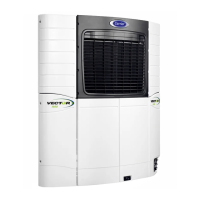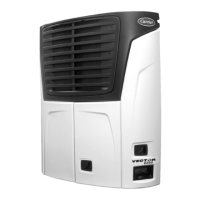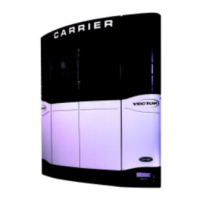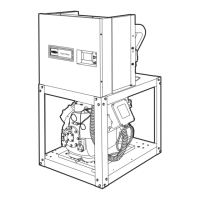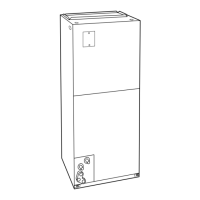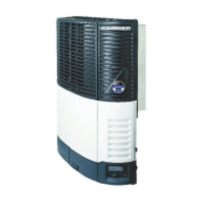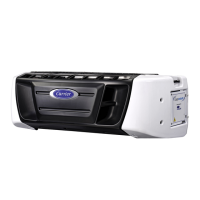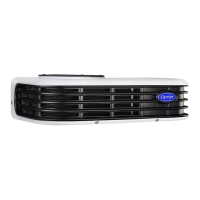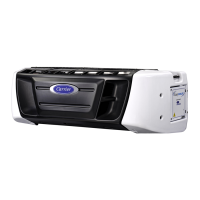62-61753-21
Checking High Pressure Switch
Do not use a nitrogen cylinder without a
pressure regulator. Cylinder pressure
I approximately 159.9 bar (2350 PSIG).
Do not use oxygen in or near a refrigerant
system as an explosion may occur.
(See Figure 8-19)
1. Cylinder Valve and
Gauge
2. Pressure Regulator
3. Nitrogen Cylinder
4. Pressure Gauge
[0 to 27.2 bar
(0 to 400 PSIG)]
5. Bleed-Off Valve
6. Switch
Figure 8-20. Typical Setup for
Testing High Pressure Switch
a. Remove switch as outlined in preceding section
b. Connect ohmmeter or continuity light across switch
terminals. Ohmmeter will indicate resistance and
continuity light will be illuminated if switch closed af-
ter relieving pressure.
c. Connect switch to a cylinder of dry nitrogen. (See
Figure 8-19)
d. Set nitrogen pressure regulator higher than close
setting for switch being tested. Pressure switch
open and closing settings are provided in Section
2.10.
e. Close valve on cylinder and open bleed-off valve.
f. Open cylinder valve. Slowly close bleed-off valve
and increase pressure until the switch opens. If light
is used, light will go out and if an ohmmeter is used,
the meter will indicate open. Close cylinder valve.
Slowly open bleed-off valve (to decrease pressure)
until switch closes (light will illuminate or ohmmeter
will indicate open).
8.6.12 Pressure Transducers
The Compressor Discharge Pressure Transducer
(CDP) has a range of 0 to 34.0 bar (0 to 500 PSIG)
while the Compressor Suction Pressure Transducer
(CSP) and Evaporator Pressure Transducer (EVOP)
have a range of -1 to 6.8 bar (-14.7 to100 PSIG). To
test the transducers, do the following:
NOTE
The Compressor Discharge Pressure on the
microprocessor Data List will never read less
than 0 bar/psig, even if it is exposed to a vac-
uum (such as when evacuating the system.)
a. Verify that the wiring to the transducer is correct.
b. Power up microprocessor, refer to Note 2, page 7-2.
Check Voltage to transducer connector. Voltage
reading between A (positive) and B (negative)
should be 5.0 VDC.
c. To check the signal wiring, check continuity between
the transducer connector C terminal and the follow-
ing microprocessor connector:
CDP = 1MP-5, CSP = 1MP-29, EVOP = 1MP-17
d. If voltage and signal wire are good, replace the
transducer. The transducer may be removed by dis-
connecting the connector and quickly backing it off
the Schrader connection.
8.6.13 Defrost Air Switch
NOTE
If the DTT temperature is above 4.4°C (40°F)
defrost cannot be initiated and the Message-
Center will show "CANNOT START DEFROST
CYCLE".
a. To check the Defrost Air Switch, run unit in cooling
and jumper across the air switch terminals. This will
start the defrost cycle as it simulates the action of
the defrost air switch. Bypassing the switch in this
manner operates all components involved in defrost.
b. Unit should remain in defrost until DTT reaches
12.8°C (55°F). At this point the defrost cycle will
terminate, and the unit will resume automatic opera-
tion.
c. If the above test indicates satisfactory operation,
test DAS settings using a Magnehelic gauge
(P/N 07-00177) or similar instrument as follows.

